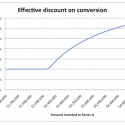The filing of Facebook’s Registration Statement on Form S-1 lit up the Web with business press and bloggers rushing to review, digest and comment on its nearly 200 pages of disclosure. IPO filings tend to draw a lot of attention, particularly given the way they’ve slowed to a trickle in recent years, but Facebook’s stature upped the ante by orders of magnitude.
 Business risks are unfortunately never as interesting to review as opportunities. It’s a well-worn joke among people involved in the financial disclosure process that the only people who pay any attention to the “Risk Factors” section of an S-1 or 10-K filing are lawyers: Those who draft it and those who review it when suing the company years later. It tends to be a mostly boilerplate section that goes on for page after page of legalistic CYA language.
Business risks are unfortunately never as interesting to review as opportunities. It’s a well-worn joke among people involved in the financial disclosure process that the only people who pay any attention to the “Risk Factors” section of an S-1 or 10-K filing are lawyers: Those who draft it and those who review it when suing the company years later. It tends to be a mostly boilerplate section that goes on for page after page of legalistic CYA language.
Nevertheless, in Facebook’s case, when called upon to review and comment on Facebook IPO risks for an article in ReadWriteWeb, I couldn’t resist digging in. There are a few exceptional risks in Facebook’s case, given its enormous size and position in the industry, that make it unique. From a financial investment perspective, any “fully valued” stock has priced in continued growth and flawless execution, so many of the risk factors describe early warning signs of developments that could topple the stock from its lofty trading price. Finally, drawing on personal experience at MySpace, I can relate all too well to the warning that “A number of other social networking companies that achieved early popularity have since seen their active user bases or levels of engagement decline, in some cases precipitously.”
You can find my commentary in part below, continuing with a link to the full article at RWW. Thanks to Dan Rowinski for the opportunity to contribute to this piece.
Facebook’s Biggest Risks Explained
Facebook is about to jump into unfriendly waters. If founder Mark Zuckerberg thought the company faced fierce competitors in Silicon Valley, he is about to find that the denizens of Wall Street are not nearly so forgiving. There are risks to going public. How does the world perceive your company? Can the platform grow and maintain its edge? The trick for Facebook will be to balance the concerns of its shareholders with the need to push the boundaries of innovation. This is no easy task.
In its S-1 filing today, Facebook outlined a litany of risks for the company going forward. Monetizing the mobile user base in a system dominated by its competitors will be a major challenge going forward. Diversifying its portfolio away from its reliance on advertising will be a big task, one that Google has never quite figured out. We take a deep dive into Facebook’s risk factors below.
What Are the Risks?
Facebook’s risks are fundamentally tied to the fact that nearly 85% of the company’s revenue is related to advertising. When most of your assets are tied to one cash vertical, any fluctuations can lead to dramatic swings in performance. Facebook also has concerns with competition, global expansion, infrastructure and retaining top talent. Here is the summary breakdown from the prospectus, with the exception of some specific stock risks.
We enlisted Antone Johnson, founder of the Bottom Line Law Group to help with the analysis of Facebook’s risk factors. Johnson is a respected Silicon Valley lawyer who has spent 15 years representing technology and media companies. He was vice president of legal affairs at eHarmony as well as assistant general counsel to Intermix Media, which included serving as director of business and legal affairs at Myspace, culminating in the company’s $650 million sale to Fox.
Johnson on Facebook’s reliance on advertising:
“Main story here is the drop from 98% to 85% of revenue being generated by advertising. Obviously a good risk mitigation approach to diversify with revenue from virtual goods, etc. Again, mobile jumps out as an important theme; given they admittedly don’t make ad revenue from mobile users, this could be a significant headwind for FB in coming years as smartphones become near-universal and people become accustomed to using them as their primary means of accessing social media.”The rest of this risk factor is par for the course.”



